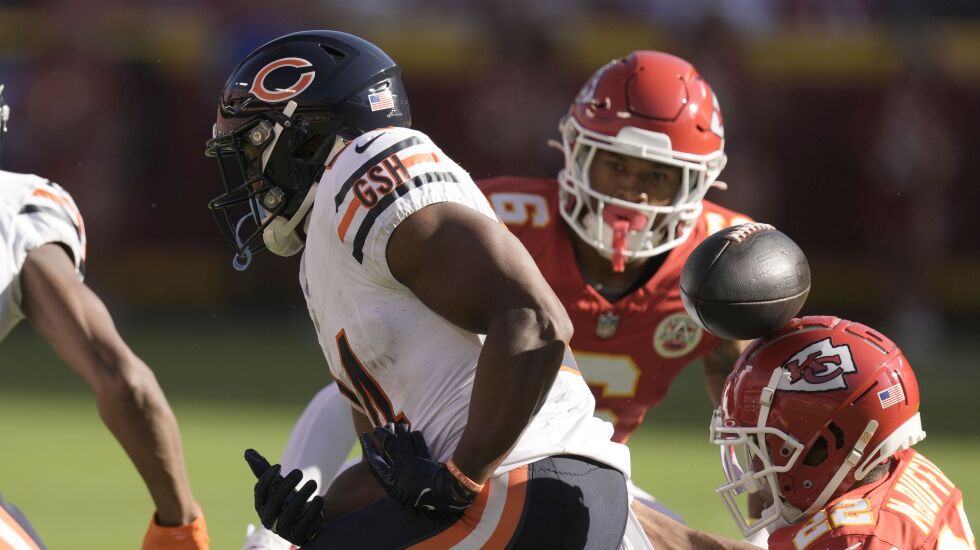
NFL teams don’t respect Justin Fields as a passer.
As a runner, though, they treat him as the Bears’ most dangerous player. All three teams the Bears have played thus far have planned to stop the quarterback from running. In Sunday’s debacle, the Chiefs’ edge rushers lingered rather than crashing down on read-option plays, content to let the Bears’ running backs do the work up the middle.
“They’re not crashing as hard as they were last year when we started doing a lot of quarterback runs with Justin,” tight end Cole Kmet said. “I think we’re going to be creative with manufacturing some times where Justin is able to take off and run and also be able to hand off and run power up the gut.
“We have to be able to do both those things.”
The Bears have their opportunity Sunday. They need to make a Broncos defense that was historically bad against the run last week pay for it Sunday at Soldier Field.
Doing so would be a strategic shift. Bears running backs have averaged only 15 carries per game. Last year they averaged 21.1.
One year after leading the NFL in rushing yards, the Bears sit almost exactly in the middle of the league, at No. 17. They’re in the bottom third of the NFL in rushes.
That’s not the formula for a successful Luke Getsy offense.
“I think that’s the biggest difference from what kind of carried us through the beginning of last season was the explosive run opportunities we created,” the offensive coordinator said this week. “And we just really haven’t created those right now.”
The Bears had 20 rushes of 20-plus yards last year, the second-most in the NFL. No one had more than their eight rushes of 40 yards or more.
This year, the Bears have only one rushing gain of 20-plus yards — a 29-yard Roschon Johnson run in the second quarter of the Buccaneers game.
“We’ve been efficient but not explosive. … ” running backs coach David Walker said. “Some of that is execution. Some of that is play design.”
Fields hasn’t been as explosive, either. One year after averaging 7.1 yards per carry, he’s down to 4.5. He’s running less often, too — from 9.4 per game last year to 8 this season.
“Especially after last year, a lot of teams are keying in on him,” Herbert said.
The Broncos will, too.
“As a runner, he’s dynamic,” Broncos defensive coordinator Vance Joseph said. “He can break tackles, he’s not sliding, and he can make you miss. He’s a challenge to rush four and hope you can contain him. Or rush five, and he can make every throw.
“It’s a cat and mouse game, but he’s obviously a gifted player. It’ll be a challenge to get him stopped.”
The Broncos focusing on Fields should open up the middle of the field for Bears running backs to do damage. They’ve yet to be able to do so — Herbert and Johnson rank No. 43 and 46 in the NFL in rushing yards.
Enter the Broncos, who gave up 350 yards on the ground to the Dolphins in Sunday’s 70-20 loss. Only eight teams have allowed more this century.
They allowed up big yards in chunks, allowing gains of 67, 52, 40, 26 and 20 yards on the ground last week alone.
Sunday, they’ll be without linebacker Josey Jewell and outside linebacker Frank Clark because of injuries, while safety Justin Simmons is questionable with a hip problem.
“We want to run the ball,” said Khalil Herbert, who leads Bears running backs with 23 carries and 93 yards this season. “(The Dolphins’ success) definitely excites you. I feel like we can do some of the same things they did last week, and even in some of the (Broncos defense’s) other games. Try to find different ways to attack them and utilize the people we have here to do the best of our ability to do some of the same things.”
If not now, when?







